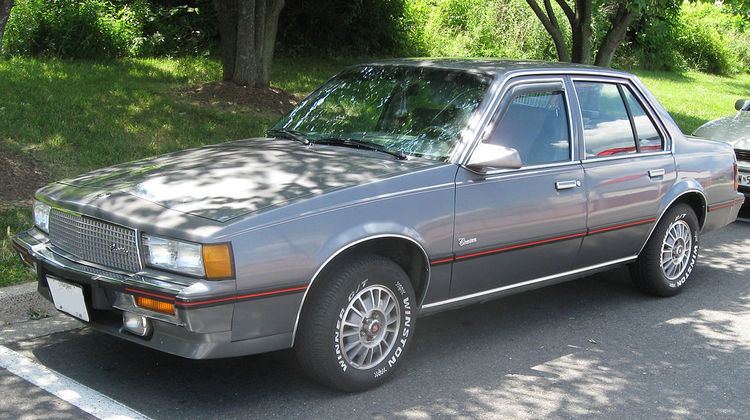Production 1981–1988 Class Compact | Model years 1982–1988 Body style 4-door sedan | |
 | ||
Assembly United States: Janesville, Wisconsin, (Janesville GM Assembly Plant)South Gate, California, (South Gate Assembly) | ||
The Cadillac Cimarron is a front-engine, front-wheel drive four door compact sedan manufactured by Cadillac for model years 1982-1988 — over a single generation.
Contents
As a rebadged variant of General Motors' J-cars, the Cimarron was manufactured alongside the Chevrolet Cavalier, Buick Skyhawk, Oldsmobile Firenza, and Pontiac J2000/2000/Sunbird at GM's South Gate Assembly and Janesville Assembly plants. Total Cimarron production was 132,499 units.
Development
Starting in 1976 GM began developing the J-body, an economy car platform intended to be shared across all its passenger car divisions. It had a 101.2 in (2,570 mm) wheelbase, torsion beam rear suspension, and standard 4-cylinder engine. The unibody's front subframe carried a MacPherson strut front suspension and transverse engine/transmission unit.
Although Cadillac had planned to introduce the Cimarron later in the 1980s, it was rushed into production early as a counter for a wave of popular similarly sized luxury European imports at the insistence of Cadillac dealers. The result was a small, slow car whose generic economy car roots were obvious.
Pete Estes, GM's president at the time, warned Ed Kennard, Cadillac's general manager:
The name was selected from a list of seven finalists, including J2000 (later used on the Pontiac), Carmel, Cascade, Caville (similar to Seville and DeVille), Envoy, and Series 62, with a preference for an initial "c". Cimarron topped the list in favorable reaction, though ironically, it evoked economy, while Caville suggested the opposite.
Design and sales
The Cimarron was introduced on May 21, 1981, initially marketed as "Cimarron, by Cadillac", and featured a straight-4 engine (the first 4-cylinder Cadillac since 1914, and the first Cadillac with an engine below 2 litres since 1908) and a four-speed manual transmission (Cadillac's first manual since 1953), with a three-speed Turbo-Hydramatic automatic optional – along with a high level of standard equipment including air conditioning, leather interior, alloy wheels, accent stripes, locking fuel filler door, power mirrors, courtesy lights, intermittent wipers, rear window defogger, AM/FM stereo radio, tachometer, tuned suspension, and stabilizer bars – pushing its base price to US$12,131 ($31,957 today), nearly double its J-body siblings. The price was otherwise commensurate with other J-body models equipped similarly.
The Cimarron received a cool market reception with first-year sales of 25,968 – a third of projections. Buyers rejected the Cimarron, recognizing it as a largely undisguised rebadged variant of a less prestigious car. Its standard four-cylinder engine was criticized for its lack of both power and refinement, and though a V6 became optional on 1985 models and was made standard in 1987, it still left questions about the Cimarron's value.
Despite having grown comparatively more refined and more distinctive by its production end, buyers stayed away, and the car was discontinued after 1988 with a final year production 6,454 units. The last Cimarron was manufactured on June 3, 1988 – with 132,499 examples manufactured over its seven-year production.
The Cimarron was put into production due to several economic factors. The United States had entered into a recession, following the effects of the 1970s energy crisis, and the United States Congress having passed the Energy Policy and Conservation Act, establishing Corporate Average Fuel Economy standards. Sales of large luxury sedans declined in favor of smaller, fuel efficient products with luxury features installed. Smaller luxury vehicles were imported into North America from both Europe and Japan, and GM responded with a small luxury sedan.
Reception and legacy
The Cimarron's failure is one in a series of events throughout the 1980s and 1990s which caused Cadillac's share of the US market to decline from 3.8% in 1979 to 2.2% in 1997; it is routinely cited as the nadir of GM's product planning:
